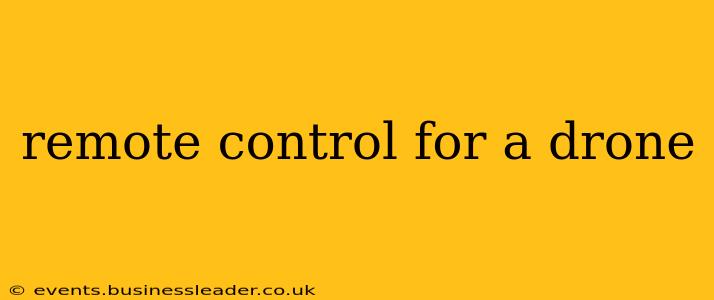Drone technology has exploded in popularity, offering stunning aerial photography, efficient surveying, and exciting recreational opportunities. But behind every breathtaking drone shot lies a sophisticated piece of technology: the remote control. Understanding the intricacies of drone remotes is crucial for both novice and expert pilots alike. This comprehensive guide will explore everything you need to know about drone remote controls, answering frequently asked questions and delving into the technology behind these essential flight instruments.
What are the different types of drone remote controls?
Drone remote controls vary significantly depending on the drone's capabilities and intended use. You'll find a spectrum ranging from simple, basic controllers for toy-grade drones to highly sophisticated, customizable units for professional-level aerial photography and industrial applications. Generally, they can be categorized as:
-
Basic Controllers: These usually come with smaller, entry-level drones. They offer basic flight controls like takeoff, landing, directional movement, and sometimes camera control. They often lack advanced features like GPS support or customizable settings.
-
Mid-Range Controllers: These controllers often feature more advanced controls, including adjustable flight modes, customizable settings, and better range. They frequently incorporate features like failsafe mechanisms and potentially some level of telemetry feedback (displaying drone battery level, GPS signal, etc.).
-
Professional Controllers: These are often modular and highly customizable, allowing pilots to configure controls to their preference. They boast extended range, enhanced telemetry, and integration with advanced accessories like gimbals and specialized camera systems. Many professional controllers support multiple frequencies and protocols for improved reliability and interference mitigation.
How does a drone remote control work?
A drone remote control transmits radio signals to the drone's receiver, instructing it to perform specific actions. The signals encode flight commands, such as throttle, pitch, yaw, and roll. Sophisticated controllers can also transmit commands to control camera settings, gimbal movements, and other drone functions.
The technology behind these controllers typically involves:
-
Radio Frequency (RF) Transmission: Most drone remotes use radio waves to communicate with the drone. Different frequencies are used to minimize interference. The strength and clarity of the signal directly impact the range and reliability of control.
-
Spread Spectrum Technology: This technique helps mitigate interference by spreading the signal across a wider frequency range. It improves the reliability of the connection, particularly in crowded RF environments.
-
Signal Processing: The controller processes user inputs and converts them into coded signals that are transmitted to the drone. The drone's receiver decodes these signals and translates them into motor commands and other actions.
What are the key features of a good drone remote control?
The ideal drone remote control depends on your needs and skill level. However, several key features are consistently desirable:
-
Ergonomics: A comfortable and intuitive design is essential for extended flight sessions. Good ergonomics reduce pilot fatigue and enhance control precision.
-
Range: A longer range allows for more extensive flights and exploration, especially beneficial for aerial photography and videography.
-
Feedback: Real-time feedback from the drone is crucial. This includes telemetry data such as battery level, GPS signal strength, and flight status.
-
Customizability: The ability to tailor control stick sensitivity, response curves, and other settings allows pilots to personalize their flight experience.
-
Failsafe Mechanisms: Built-in safety features like automatic return-to-home (RTH) functions are vital for preventing accidents in case of signal loss or other issues.
Can I use any remote control with any drone?
No. Drone remotes and drones are generally not interchangeable. They are designed to work together using specific communication protocols and frequencies. Attempting to use a mismatched controller can result in unpredictable behavior or complete failure of the drone. Always use the remote control specifically designed and supplied with your drone model.
How long does the battery last on a drone remote control?
Drone remote control battery life varies significantly depending on the model, usage patterns, and other factors. Many controllers use rechargeable lithium-polymer (LiPo) batteries, offering flight times ranging from several hours to only a few. It's always wise to check your specific controller's specifications for battery life information. Always have spare batteries available for extended flight sessions.
How do I maintain my drone remote control?
Proper maintenance of your drone remote ensures reliable performance and longevity. This includes:
- Regular Cleaning: Wipe down the controller periodically to remove dust and debris.
- Battery Care: Charge and store LiPo batteries correctly according to the manufacturer's guidelines.
- Firmware Updates: Keep your controller's firmware up to date to benefit from bug fixes and performance improvements.
- Antenna Care: Avoid bending or damaging the controller's antennas, as this can compromise signal strength and range.
Understanding your drone's remote control is paramount to safe and enjoyable drone operation. By understanding its features, capabilities, and maintenance requirements, you can unlock the full potential of your aerial system and capture breathtaking footage or accomplish your desired tasks with confidence.
